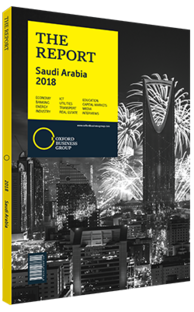Vision 2030 investment bodes well for construction in Saudi Arabia
The long-term development plan Saudi Vision 2030 seeks to transform the economy from powerful but hydrocarbons-dependent to diversified, dynamic and knowledge intensive, with a high standard of living for all citizens. One of the most ambitious policy documents published by any country, it is already having an extensive impact on the construction sector.
Since its publication in April 2016, the government has rapidly moved ahead with a range of developments and reforms that had an immediate impact on construction demand. The National Transformation Programme, which runs to 2020, is central to the delivery of Vision 2030’s medium-term targets, and has led to the launch of large-scale investments in sectors from utilities to tourism. While strategic government plans in rapidly growing markets can often take the form of a list of aspirations rather than a practical programme, it is clear from early implementation efforts that Vision 2030 is already taking a concrete form.
Related Aims
Vision 2030 should help drive construction growth directly and indirectly over the next 15 years through its multi-faceted approach to economic and social development. Perhaps most significantly, the plan aims to boost non-oil revenue to SR600bn ($160bn) by 2020 and SR1trn ($266.6bn) by 2030 from a baseline of SR163bn ($43.5bn) in 2015. Sectors expected to take the lead in diversification efforts include transportation and logistics; high-value manufacturing, including for the defence industry; renewable energy; and mining, with the government aiming to increase the latter’s economic contribution to SR97bn ($25.9bn) in 2030 from just SR520m ($138.6m) in 2015. Developing these sectors will entail extensive construction of roads, railways, ports, airports, power plants, factories, mines and supporting infrastructure.
Even the government’s challenging fiscal reform programme under Vision 2030 has some upsides for the industry, with the revenue-raising white land tax expected to catalyse construction in major urban areas through incentivising development over land holding (see analysis). Another move to raise funds is the initial public offering of a 5% stake in Saudi Aramco, the world’s largest oil company, expected in 2018. The offering will help boost investment in the energy sector and support the greater integration of Saudi Arabia’s economy into global markets, stimulating growth more broadly. The Public Investment Fund (PIF) – Saudi Arabia’s sovereign wealth fund – is playing a leading role in pushing Vision 2030 forward, including through a range of multibillion-dollar construction projects in major cities. Already a sizeable entity, the government aims to transform the PIF into a $2trn sovereign wealth fund to manage projects across all sectors.
Vision 2030 also aims to increase the proportion of homeowners among the Saudi population from 47% in 2016 to 52% in 2020, which will entail the development of a large number of new homes. Plans for a new green card system encouraging foreign nationals to pursue long-term employment in the Kingdom, as well as easing restrictions on property ownership by expatriates, should also boost demand for residential property.
Investment Growth
In a February 2017 report on Vision 2030, professional services company KPMG highlighted areas in which the state had already earmarked large sums for investment, much of which will have a direct impact on demand for construction services. Project outlays include $90bn for new metro lines and bus routes in Riyadh, Jeddah, Makkah and Medina; $8bn for the expansion of the railway network; and the completion of the $67bn King Abdullah Economic City.
The construction of the King Abdullah City for Atomic and Renewable Energy is expected to cost $1.33bn through to 2020, while $11bn allocated to health care will see investments in new hospitals and clinics, and in factories producing medical supplies. In addition, to rapidly develop the tourism sector, the government aims to attract 1.5m leisure visitors by 2020 through easing visa restrictions and attracting investment in hotels.
You have reached the limit of premium articles you can view for free.
Choose from the options below to purchase print or digital editions of our Reports. You can also purchase a website subscription giving you unlimited access to all of our Reports online for 12 months.
If you have already purchased this Report or have a website subscription, please login to continue.

